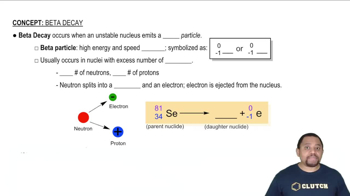Here are the essential concepts you must grasp in order to answer the question correctly.
Half-life
Half-life is the time required for half of a sample of a radioactive substance to decay. In this context, Fluorine-18 has a half-life of 110 minutes, meaning that after this time, only half of the original amount remains. Understanding half-life is crucial for calculating how long it takes for a specific quantity of a radioactive isotope to decrease to a desired level.
Recommended video:
Exponential decay
Exponential decay describes the process by which a quantity decreases at a rate proportional to its current value. For radioactive substances like Fluorine-18, the amount remaining after a certain time can be calculated using the formula N(t) = N0 * (1/2)^(t/T), where N0 is the initial amount, T is the half-life, and t is the elapsed time. This concept is essential for determining how long it takes for the amount of Fluorine-18 to drop from 250 mg to 75 mg.
Recommended video:
Radioactive decay equations
Radioactive decay equations are mathematical expressions used to model the decay of radioactive isotopes over time. These equations allow us to predict the remaining quantity of a substance after a given time period. In this problem, applying the decay equation will help calculate the time required for the Fluorine-18 dose to decrease from 250 mg to 75 mg, which is a key step in solving the question.
Recommended video:
Rate of Radioactive Decay

 Verified step by step guidance
Verified step by step guidance


